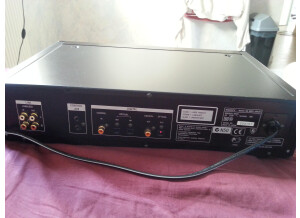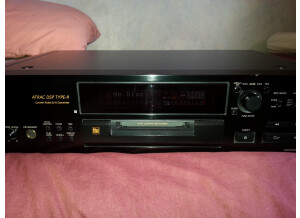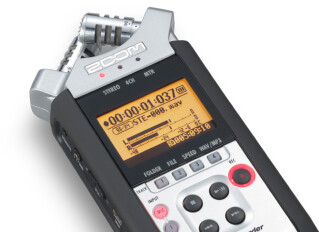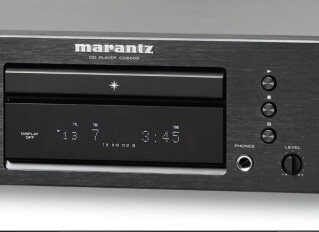Annonces MDS-JB930
Alerte nouvelle annonceImages
Fiche technique
- Fabricant : Sony
- Modèle : MDS-JB930
- Catégorie : Platines MD
- Fiche créée le : 02/09/2020
As you might expect from an item in the SONY QS range, the finish and fit on this unit (all black in this case) is superb. It feels solidly constructed and conveys an immediate sense that this is a quality product which has been built to last. All of the front panel controls operate smoothly and effortlessly, and once loaded with an MD, recording and playback is very quiet with no distracting mechanical noises which are the curse of some portable units. One of the Sony catalogue errors is immediately revealed. The catalogue says it has ATRAC version 4.5, but smart gold lettering on the front panel reveals the truth that the 930 has the very latest ATRAC DSP Type-R, as well as Current Pulse D/A Converter. There is also a natty little red plaque on the front that reads ``UK Special Edition''. All that's missing are the ``Go-Faster'' stripes. The overall dimensions are in keeping with Sony's traditional sizing of large hi-fi separates vis. W 430 x H 110 x D 287 mm. Appearance is a very subjective thing, but I think this unit looks simply gorgeous and is a perfect visual match with my Sony ST-SE700 tuner and CDP-337ES-D CD. The IR remote control unit is a bit on the big side, but since it does so much I can forgive it for having been fed on steroids. There are no discernible ventilation holes, but with a rated power consumption of just 18 watts, I presume Sony felt it was unnecessary. We all know, however, that with continuous recording use, the laser can generate a significant heat build up, and my discs felt pretty warm straight out of the deck after recording. I think it would be sensible to position the unit so that the outer casing benefits from a reasonable airflow.
What's On the 930FRONT PANEL (from top left to bottom right):
- Power standby switch. A red LED within the switch glows when switched off to indicate mains power is still on line.
- Timer switch (Off / Rec/ Play). Note - this unit still requires you to buy a separate timer for unattended use.
- Large headphone socket with a headphone volume control alongside.
- PS/2 computer keyboard socket. A keyboard can be directly connected to both control the unit and enter titling (no software required). I have not had time to use this yet so cannot comment on its effectiveness.
- pitch control button - to alter the playback pitch.
- Filter button - providing four different digital sound envelopes to the analogue output stages.
- Time button - to display number of tracks and time either recorded or still left.
- Play Mode button - to select shuffle or programmable playback.
- Scroll Button - to scroll track titles across the display once per push. It's a shame Sony still haven't adopted Sharp's much better idea of allowing scrolling to be continuous whilst a track is playing, so that long titles can be read at a glance.
- Display/Char button - provides access to various information display modes and character input options.
- Display Window - located in the top centre of the facia, this is a two line display which is very clear to read and provides various information depending on the operating status.
- MD Insert Slot - also centred on the front panel but underneath the display. Transport in and ejection of the discs is very smooth indeed.
- AMS rotary knob - grouped together with three buttons, Menu/No, Yes, and Clear, this allows selection of tracks, setting the clock, selecting titling characters and selecting menu items and set-up values. It can also be pushed once to start Time Recording (see Features).
- Eject - this largish button triggers TOC Writing before ejecting the disc.
- Record Mode switch - a two position switch to select Mono or Stereo recording.
- Input switch - a four position switch to select from one of the input source sockets on the back panel ( Opt 1, Opt 2, Coax, or Analogue )
- Record Level - This rotary knob allows you to adjust recording levels either before or during recording in both Analogue and Digital recording modes.
- Operation Controls - The usual group of six buttons provide for Fast Fwd, Fast Rev, Record, Play, Pause and Stop.
BACK PANEL (from top left to bottom right):
- Line - 4 phone sockets for left & right line-in and line-out to your amplifier.
- Control A1 II - there are two mini-jack sockets for A1 Mk II control connections to compatible components. I don't have any other items with this feature so they won't get used here.
- Digital - there are Two (yes 2!) Optical Toslink In, one Coaxial In, one Coaxial Out, and one Optical Toslink Out sockets. If this isn't enough for all your needs you must be living in a space station. (:o) All the sockets are gold plated.
- Mains lead - is of the captive type with a 3 pin plug fitted.
This will obviously vary according to individuals' circumstances and requirements. For me it was a simple matter of connecting the Toslink optical fibre cable between the OPT 1 input of the 930 and the OPT Out on my CD deck to enable digital recording from CDs. Then the two phono leads were used to connect the Line In / Line Out sockets to the equivalent sockets on my Sony Amplifier (TA-AX360 Receiver), to allow me to make MD recordings from my other analogue components i.e. turntable, cassette tape recorder (yuk! washes mouth out with soap and water), and radio tuner, as well as facilitate playback of the 930 through my hi-fi. All that remained was to program the 930's internal clock with date and time which is so simple even a hamster could do it in 30 seconds. Unfortunately, I don't own a hamster, so it took me 3 minutes.
Features- All the usual editing features like Track Erase, Combine, Divide, etc.etc. are available either from the front panel, attached keyboard or the remote, and are very easy and intuitive to use. One feature which I have not come across before from my previous experience of portable MDs is an Edit Undo which allows you to undo the last edit action so long as the TOC has not yet been written. I can see this could be very useful, particularly when I've had a few beers too many.
- Adjustable Recording Level - this works both when recording from analogue and digital inputs, and can be adjusted during and without interrupting recording, which is handy if you get caught out by an unexpected high level passage in the source material.
- Sync Recording - there are two functions on the remote which deal with synchronised recording vis. CD-SYNC and MUSIC SYNC. Neither of these work in quite the same way as I am used to with my Sharp 821 or my Sony MZ-R35, both of which start and stop exactly when the CD content starts and stops when using the optical cable. CD-SYNC is nothing more than a process of using one button on the remote to simultaneously command the 930 to go into Rec/Pause and your CD deck (if it is compatible with the remote) to go to Playback/Pause. A second Start button is then used to simultaneously command the 930 to start recording and the CD player to start playing. Sony do warn that some CD players, even those made by them, might not react to the final play command ... and Sod's Law dictated that mine would not ... so I shan't be using that rather pointless facility. MUSIC SYNC on the other hand, is more like my portables in that it just puts the 930 in REC/PAUSE mode, and as soon as you start the Source material to play, recording automatically commences. Obviously, when recording digitally from CD, all track marks are automatically logged. The one thing that really puzzled me at first is that, in neither CD-SYNC nor MUSIC SYNC, and unlike my portable MDs, recording does not stop immediately the source material stops. What actually happens is that if the source material recommences within 30 seconds, the 930 automatically truncates the quiet gap to 3 seconds; so you have the convenience of changing your source material within 30 seconds without having to set up recording mode again, but only end up with a gap of 3 seconds between the items on the finished disc... very clever and useful if recording selected tracks from various LPs or CDs for example. If you leave it for *more* than 30 seconds after the source material ends, the 930 automatically puts itself into REC/PAUSE mode to await your return, and again it truncates the blank space to just 3 seconds on the disc.
- Track Marking & Naming- can be carried out whilst recording as well as after the event.
- Time Machine Recording - I love this facility. So long as source material is playing and the 930 is in REC/PAUSE mode, a 6 second buffer stores the material and if you initiate recording with the T.REC button, those previous 6 seconds worth are first delivered from the buffer to the disc. This is so useful when recording off the radio ... you need never miss the start of a piece of music again as you effectively have 6 seconds to hit record after you hear the start.
- Fader - Another facility which I really love, and the 930 executes it so well. Both in Record and Playback modes, a single button press on the remote invokes a 5 second fade in or fade out. The pre-set 5 second duration can be altered in the menu settings, but I have found 5 seconds to be just perfect in making really professional sounding segues.
- Sleep Timer - you can set the 930 to automatically switch off after 30, 60, 90, or 120 minutes.
- Filter button - this deck has four settings of Digital Variable Coefficient filters ( described as Standard, Spline, Plain, and Analogue) to tailor the output analogue signals from the Line-out and headphone jack. This is a really useful feature and I've had great fun experimenting with these settings and trying to decide which one best suits my speaker set-up and headphones for various styles of music. Sony describe these as: Standard - an expansive sound of wide range; Spline - a sound that is clearly positioned and smooth; Plain - a fresh and powerful sound; Analogue - a resonant and mellow sound. Mmmm ... nice (:o).
- pitch control button - using the AMS jog dial you can alter playback pitch by 2 steps up or 48 steps down (each 12 steps = 1 octave) and a further fine pitch control allows 0.1% incremental adjustments between -98.5% and +12.5%. Don't let the kids loose on this or, once they find they can make Kate Bush sound like Paul Robson, you'll never get them off.
As I've always maintained, no matter how many bells and whistles an MD's got, if it doesn't deliver on sound, you've wasted your money. Well the good news is that the 930 delivers Big-Time. The DACs in this unit are simply superb, and have been giving my old Sony amp a real work-out. All the discs previously recorded in either my MZ-R35 or 821 portables play perfectly (possibly of interest to those in this NG who were recently asking about player compatibility) and they sound so much better, not just through my KEF speakers (designed and made them myself) but also through the headphone jack. Yesterday I did some test recordings off air from the tuner. A stereo play on Radio 4 recorded on location played back with breath-taking clarity and a perfectly placed and spacious ``stereo stage''. Tracks recorded from my old LP collection also recorded faithfully but, and others have commented on this, somehow those old LP tracks sound so much more vivid and fulsome on MD, why I don't know. The very first minidisc I ever bought was pre-recorded ... Jean Michel Jarre 's ``Images'', a compilation of his best works ... and this electronic music has a very wide dynamic range with outrageous transient peaks. All I can say is that playing it on the 930 has to rate as one of my all-time mind blowing experiences.
ConclusionIs the Sony JB930 good ? NO ... good does not even begin to describe it. In my humble opinion, there just aren't enough superlatives in the world to describe this gem. Sony may not always get it right, but this time they get Ten Gold Stars. (Dave Chambers)
Distribué par DADIS (Digital Audiovisuel Distribution)
Autres catégories dans Enregistreurs numériques
Autres dénominations : mdsjb930, mds jb 930









